Address any questions or comments regarding this newsletter to the individual authors listed after each article or to its editors, Nathan Johanning, 618-939-3434, njohann@illinois.edu or Bronwyn Aly 618-695-6060, baly@illinois.edu. The Illinois Fruit and Vegetable News is available on the web at: http://ipm.illinois.edu/ifvn/. To receive or be removed from email notification of new postings of this newsletter, contact Nathan Johanning or Bronwyn Aly at the phone numbers or email addresses above.
In This Issue:
Upcoming programs (listings for beginning and established growers)
Regional Reports (northern, west central Illinois, southern Illinois, Dixon Springs)
Fruit & Vegetable Production & Pest Management (Managing Soil Fertility: Taking a “Good” Soil Sample)
Upcoming programs
See the University of Illinois Extension Local Food Systems and Small Farms Team’s website at:
http://web.extension.illinois.edu/smallfarm/ and the calendar of events at http://web.extension.illinois.edu/units/calendar.cfm?UnitID=629.
- Great Lake Fruit, Vegetable, & Farm Market Expo, December 10-12, 2019, DeVos Place, Grand Rapids Michigan. For more Details and full agenda visit https://glexpo.com/
- Illinois Farmers Market Association 2019-2020 Winter Webinars. If you are looking for great webinars that have a market focus check out this series from ILFMA and University of Illinois Extension. They are hosting one per month, between now and March 2020. Registration for the webinars listed below can be found here: Check it out! For more information, contact Laurie George ljgeorge@illinois.edu
- December 16, 2019 “Pollination Celebration: Opportunity to Connect our Food System, Our Environment and Our Community”
- January 13, 2020 “Food Safety Modernization Act (FSMA) Produce Rule for Farmer’s Markets: Is It Required?
- February 10, 2020 “Inside Look at Successful Chef Demos at the Market
- March 16, 2020 “The Future of Farmers Markets – Building Collaborative Practices”
- 2020 Kentucky Fruit and Vegetable Conference, Sunday, Monday and Tuesday, January 5-7, 2020, Embassy Suites Hotel, 1801 Newtown Pike, Lexington, Kentucky 40511. For more information visit https://kyhortcouncil.org/2020kyfruitandvegconf/
- 2020 Illinois Specialty Crops Conference, January 8-10, 2020, Springfield, IL. Save the date!!!! https://www.specialtygrowers.org/2020-save-the-date . More information to follow later in the year but mark your calendars now and plan on attending the pre-conference workshops, conference programming, trade show, and annual association meetings!
- 2020 Southwest Illinois Commercial Tree Fruit School, Tuesday, February 4, 2020 at the Knights of Columbus Hall just south of Hardin, IL. Save the date and more information to follow!
- 2020 Southern Illinois Fruit and Vegetable School, Wednesday, February 5, 2020, Mt Vernon Doubletree Inn. This program includes separate tracks for small fruit, tree fruit and vegetable production. Save the date and more information to follow!
- Indiana Hort Conference & Expo, February 11-13, 2020. Indianapolis Marriott East Hotel, 7202 East 21st Street, Indianapolis, IN 46219. For more details visit https://www.indianahortconference.org/
- 2020 North American Raspberry and Blackberry Conference, Tuesday-Friday, March 3-6, 2020 in St. Louis, MO. Save the date and watch for conference registration very soon! https://www.raspberryblackberry.com/2020-north-american-raspberry-blackberry-conference/
Hotel accommodations can be made now. Here is the link for hotel information: https://www.raspberryblackberry.com/conference-accommodations/ Don’t miss the opportunity to attend this national conference and learn more about caneberry production!
Regional Reports

Growth achieved on tillage radish from Extension demonstration plots in northern Illinois.
Photo by G. McCarty
From northern Illinois…Snow has made its appearance this week in Northern Illinois (11/11) with around 4-6 inches of snow received in many areas. This week, we are expecting to remain close to 10 F. We’ve been growing tillage radish this fall in some of our Extension demonstration beds. All beds were planted on August 1st and in the photo is one that was harvested on October 23rd. While a grower could still push back planting to tillage radish to mid-August in Northern Illinois, I find that the overall growth and health of the cover crop stand benefits being planted that first week of August. Because of this, it may or may not fit in well to your growing season. In checking the cover crop plots last week, most of the tillage radish has started to winter-kill which is the goal of this cover crop to then break down into winter and spring to add beneficial organic matter and address soil compaction.
Grant McCarty (815-235-4125; gmccarty@illinois.edu)
From west central Illinois… The work is hard, and this year did not make it any easier, but around this time of year, I tend to see a lot of smiles. Growers saying, “We’re all done!” or “We pulled the last of our crops.” Relief at being done with another growing season. Done with fieldwork. Done with managing people. Time to put on tacky holiday sweaters and kick back.
However, I know most farmers don’t take to sitting still very well. Many are back to work at their off-season jobs, planning for next season, prepping new plots, getting tunnels, lights, and equipment ready. Some have processed some livestock for winter, while others continue to grow and supply local grocers and restaurants with cool-season crops and greens.
At the McDonough GIFT food donation garden, the beds have been replenished with compost and cover crops. New beds that will host potatoes next year have been planted in tillage radish. The garlic is in. With special thanks to the WIU horticulture students for helping get twenty pounds of garlic planted. Irrigation lines have been drained and all hard plastic fittings have been removed. We have relied on gravity to drain our drip irrigation lines in the past, but this year I hooked up an air compressor to blow out the lines and was shocked at just how much water remained.
As we often look back in retrospect at the former growing season, one conversation stands out in my head. This grower had dozens of peach and pear trees that were girdled and killed by voles during the previous winter. Therefore, remember to protect fruit trees from voles this winter.
When talking about vole management I prefer to start with cultural controls. The first step is to reduce the desirable habitat for voles. Closely mowed rows and field edges will open voles up to attack from predators. A vegetation-free strip under the fruit tree canopy can provide a reduction in vole feeding damage. Providing aerial predator perches and habitat will encourage more hawk and owl predation on voles.
Placing sheets of tin or aluminum near field edges encourages snakes. Despite humans natural fear of snakes, remember these slithery serpents don’t cause crop damage, but can help reduce it. Remove the metal pieces in the late fall so not to give voles a hiding spot overwinter.
Plastic guards can be placed around the base of trees to protect from gnawing critters. Remember to remove these in spring.
Some growers turn to repellents often containing capsaicin that offer a short window of control. Make sure to check your product labels to ensure they can be used on fruit trees.
For small orchards, you can use multi-catch traps. Identify a vole run and place trap in the run and bait with some rolled oats or birdseed.
Chemical control for voles is in the form of poisons that are either fast-acting (zinc phosphide) or require multiple feedings (anti-coagulant). The anti-coagulant baits often pose less risk to other wildlife, but regardless of what you use, every effort should be made to prevent non-target species from being affected. Use bait stations with pelletized formulations and avoid the grain-based formulations.
Chris Enroth (309-837-3939; cenroth@illinois.edu)
From southern Illinois... It feels like we have bypassed any remainder of fall and now straight into winter in southern Illinois. We had been around normal to maybe a little cooler. Sunday (11/10) it was sunny and almost 70˚ and Tuesday morning it was 14˚ and we had a little sleet/ice with about and inch or so of snow. Late last week we had about 0.7” of rain in Murphysboro which left things fairly wet. There was less rain to the north. Now, temperatures are slowly starting to rebound after about 36 hours below freezing. Highs are supposed to be in the mid 40s and even the 50s by next week and farily dry conditions throughout the next week as well.
Things have pretty well come to a stop for the growing season outside. Uncovered fall crop plantings have taken some abuse from the recent weather. In the high tunnel, cool season crops are still pretty happy especially under row cover the last few nights. In the orchard there is some fall clean up and some larger orchards have started on some apple pruning.
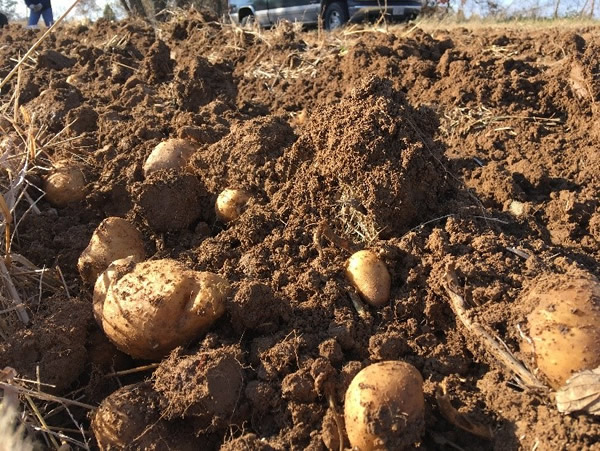
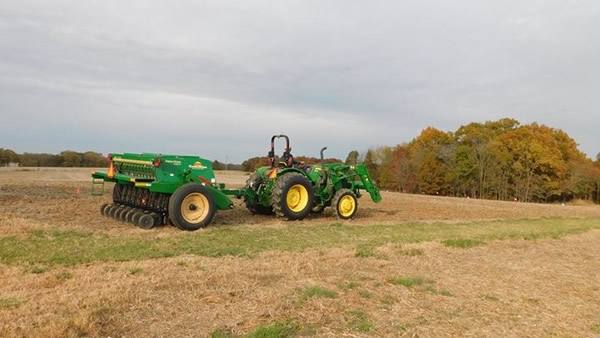
Late-potato harvest at the family farm of ‘Kennebec.’ (top)Photo: N. Johanning
With many things going on with pumpkin harvest, work, and family, my potatoes at home had gotten a little neglected. They should have been dug in August, and I have never (in the last 3 + decades nor the years before my grandpa and great grandpa probably) dug potatoes after Labor Day weekend…until this year. We dug them on Sunday (11/10) with the 70˚ and sunshine and ironically the quality and yield was better than years where I “thought” I was doing everything “right.” It was a little wet but not too bad, Kennebec has always been our staple variety and over multiple trials etc. has been a strong yielding variety. This year the Kennebec yielded over twice the Yukon Gold. I think this was more due to all of the rain in the spring and being and earlier season variety than Kennebec. In the past yields between the two were more comparable. Quality was good with limited rotten tubers or wireworm damage. I think the dry weather we had through mid-October helped them hold well in the soil. We all have had things like this that we know better, but time just doesn’t allow; fortunately this year things didn’t work out too bad.
We were able to get our cover crops planted for the other research site for our cover crop/tillage system trials on tomatoes and peppers at the Baebler Education Farm south of Waterloo. This is a 103 acre farm that was donated to the Monroe County Extension & 4-H Foundation. They have about 30 acres of rolling cropland and the remainder is woods with hiking trails, CRP, and some small lakes. I am excited to be working with the foundation and this farm and you will probably be hearing more reports about projects from there in the future. Also thank you to the Monroe County Soil and Water Conservation District for the use of their No-till Drill.
All things considered what are some things you can be doing this time of year. Fall clean up in-field and sheds, cleaning/sanitation of harvest containers, soil sampling (see article later in this issue), assessing the season and any changes to make for 2020 any equipment needs that might aid in efficiency/crop quality/labor savings, assessing varieties you like/dislike. It can be easy to just get caught up in the holidays and other things now that the growing season has mostly ended but now can be a good time to assess some of these things while they are fresh on you mind. Also don’t forget to make plans to attend some winter meetings and educational programs! Check out the calendar of events for some of the up coming programs!
Nathan Johanning (618-939-3434; njohann@illinois.edu)
From Dixon Springs Ag Center…
We had a few cold nights last week in which overnight lows were in the mid to upper 20s, and a few of those nights warranted covering designated plots in our high tunnel winter vegetable production project. Our protocol for this project requires covering of plots with floating row cover when predicted lows will be 25 F or less. Not all plots are covered as part of this project is making comparisons between covered and uncovered.
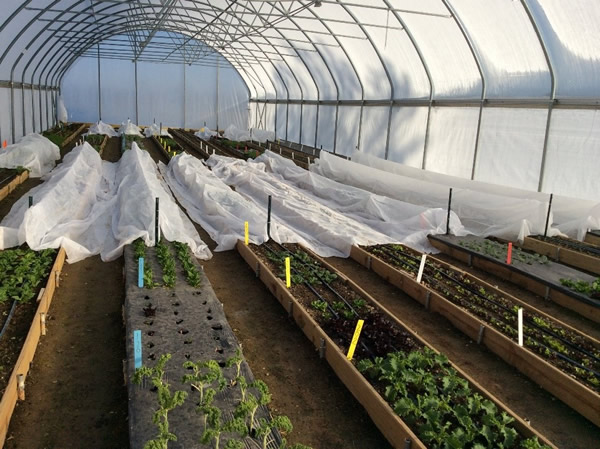
Lettuce, kale, spinach, and carrot plots growing in high tunnel at DSAC. Some plots have been covered with floating row cover. Photo by Katie Bell.
Acclimating to cold weather can be challenging for those of us in southern Illinois because we can be at 65 F (Sunday, November 10th) and then hit 25 F within the same 24 hour period (Monday, November 11). With the incoming extreme cold blast on Monday, all designated plots were covered and will remain covered until Wednesday.
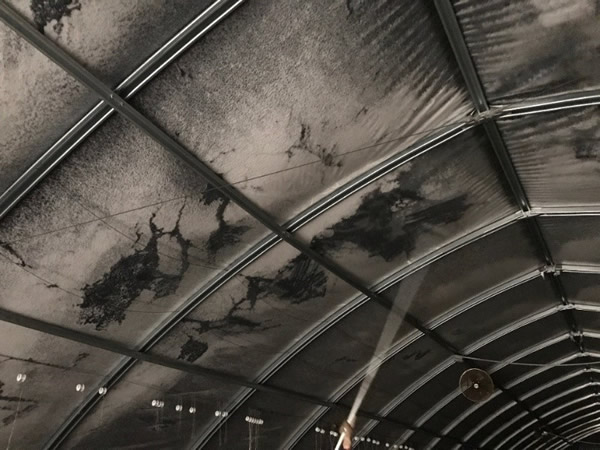
Sleet and then dry snow started coming into our area late Monday afternoon. One of the four high tunnels at DSAC has bows on 6 foot spacings, has no trussing, and suffers from some slight warping on a few of the bows. With this combination, the plastic can’t be stretched as tight as we would like and sagging pockets form in several spots throughout the tunnel. These pockets hold water when it rains as well as snow. Any additional weight in these pockets causes more stretching of the plastic and hence creating even deeper areas of sagging that don’t shed the rain/snow. Too much weight from pooled rain/snow could collapse the tunnel.
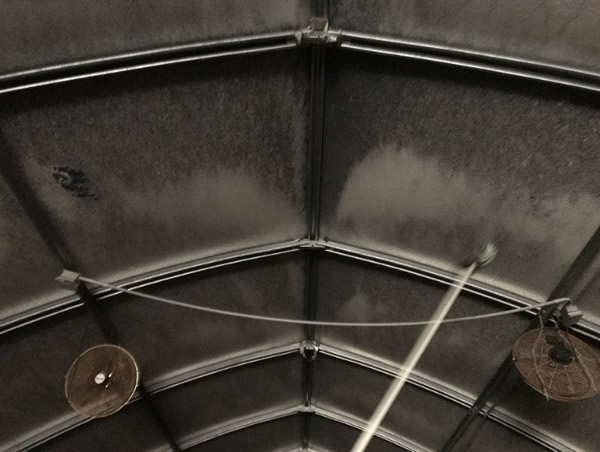
Snow and ice removal from high tunnel at DSAC. Photo by B. Aly.
The picture on the top right shows a couple of areas that suffer from pooled precipitation – note the puckering of the plastic in the upper right corner and the sag with snow directly below. Compare plastic in that picture to the picture on the bottom right. In the second picture, the plastic is tight, with no puckers or sags. As we don’t want to have a collapsed high tunnel frame, we would rather err on the side of caution and remove any amount of rain/snow that collects on the plastic. Our high tech snow removal device is a scrub brush attached to an extendable pole with a shirt duct taped over the brush. Since most of our sagging areas are on either side of the peak, we bump the plastic on the inside and “pop” it off the plastic and out of the sagged areas.
The other three tunnels at DSAC all have W trussing on the bows and plastic is able to be stretched tightly over the top, allowing them to withstand a greater snow load without fear of collapse. In a wet snow event with accumulation potentials, we would also be monitoring their status and removing snow as necessary.
Bronwyn Aly (618-382-2662; baly@illinois.edu)
Fruit & Vegetable Production & Pest Management
Managing Soil Fertility: Taking a “Good” Soil Sample
Now is often the time of year that we think about soil sampling and getting a handle on the fertility needs of our fields. This is a great time to get this out of the way while soil conditions are good to pull cores and the weather temperatures are still fairly decent. One of the keys to getting good soil sample results is to take a good sample. Almost any lab (or soil fertility instructor) will tell you that your results are only as good as the quality of the sample you take. Here are a few recommendations on how to take a “good” sample:
- Choose sample areas based off of previous management, crop history, slope, and soil type. Fields can vary in nutrient levels based off of management practices that occurred even many years before. Some examples of things to consider would be old field borders, band applied fertilizers (especially Lime, P, & K), or any differences you have observed in crop growth. If you do not sample these areas separately, the results from one area might dilute or inflate the level, not giving you an accurate assessment of the field.
- Size of each sample area. Generally I would recommend a maximum sampling area size of no more than 5 acres (2.5 acres preferred) at least until you have a baseline understanding of the field. However, for many specialty crop growers with smaller field sizes this would probably be much smaller with samples potentially every half acre or less. Again I would base the size more off of management and history than just a set number of acres.
- Pull 6 to 10 cores (6 to 7 inches deep) and mix together to form your sample. This gives you a good representation of the variability of an area, and this number of samples helps to control for any small-scale variability in the field. Mix well and fill to the fill line on the soil sample bag, which is usually no more than a pint. You can discard any extra soil; no need in paying for extra shipping and most soil labs already have an abundance of extra soil so they probably would prefer not have any more in excess.
- Use a probe or spade to get a sample that is representative of the top 6 -7 inches of the soil. The reason being we typically consider this zone in the soil to be the primary rooting zone and your sample should equally reflect that profile. You want to have just as much soil from 6 inches down as the top inch so you are not biasing the sample for possible increased fertility. A soil probe is the easiest tool to do this with.
- Keep good records. Record the sampling areas and how you designated them. This will help you when you take samples in the future (every 3-4 years) to be able to compare back so you can see how your management practices have changed the soil fertility levels. Also, if you are comparing from year to year, it is recommended to always try and sample at the same time of year for the most consistency.
Hopefully this gives you a few thoughts on how to take a “good” soil sample as it really is crucial to success. Also, if you are looking for a soil lab you can find a list of accredited labs from the Illinois Soil Testing Association at http://www.soiltesting.org/5certifiedlabs.html.
Nathan Johanning (618-939-3434; njohann@illinois.edu)
Less Seriously
https://www.thanksgivingnovember.com/thanksgiving-jokes.html
1. What key has legs and can’t open doors?
A Turkey!
2. What do you call a dumb gobbler?
A jerky turkey!
3. What do you call a gobbler who thinks he knows everything?
A smirky turkey!
4. What has feathers and webbed feet?
A Turkey wearing Scuba Gear!
5. Why did the turkey cross the road?
It was the chicken’s day off.
6. Why did the police arrest the turkey?
They suspected it of fowl play.
7. What sound does a space turkey make?
Hubble, hubble, hubble.
8. Why do turkeys always go, “gobble, gobble”?
Because they never learned good table manners!
9. How can you send a turkey through the post office?
Bird class mail!
10. Why did they let the turkey join the band?
Because he had the drumsticks
11. What happened when the turkey got into a fight?
He got the stuffing knocked out of him.
12. How do you make gold soup?
Just throw in fourteen carrots (carats).
13. What kind of vegetable would you like tonight?
Beets me!
14. Why did the man invest in feathers?
He heard the stock market was going down.
University of Illinois Extension Specialists in Fruit and Vegetable Production & Pest Management
Extension Educators – Local Food Systems and Small Farms |
||
Bronwyn Aly, Gallatin, Hamilton, Hardin, Pope, Saline, and White counties |
618-382-2662 |
|
Katie Bell, Franklin, Jackson, Perry, Randolph, & Williamson counties |
618-687-1727 |
|
Sarah Farley, Lake & McHenry counties |
847-223-8627 |
|
Nick Frillman, Woodford, Livingston, & McLean counties |
309-663-8306 |
|
Laurie George, Bond, Clinton, Jefferson, Marion, & Washington counties |
618-548-1446 |
|
Zachary Grant, Cook County | 708-679-6889 | |
Doug Gucker, DeWitt, Macon, and Piatt counties |
217-877-6042 |
|
Erin Harper, Champaign, Ford, Iroquois, and Vermillion counties |
217-333-7672 |
|
Grace Margherio, Jackie Joyner-Kersee Center, St. Clair County |
217-244-3547 |
|
Grant McCarty, Jo Daviess, Stephenson, and Winnebago counties |
815-235-4125 |
|
Katie Parker, Adams, Brown, Hancock, Pike and Schuyler counties |
217-223-8380 |
|
Kathryn Pereira, Cook County |
773-233-2900 |
|
James Theuri, Grundy, Kankakee, and Will counties |
815-933-8337 |
|
Extension Educators – Horticulture |
||
Chris Enroth, Henderson, Knox, McDonough, and Warren counties |
309-837-3939 |
|
Richard Hentschel, DuPage, Kane, and Kendall counties |
630-584-6166 |
|
Andrew Holsinger, Christian, Jersey, Macoupin, & Montgomery counties |
217-532-3941 |
|
Extension Educators - Commercial Agriculture |
||
Elizabeth Wahle, Fruit & Vegetable Production |
618-344-4230 |
|
Nathan Johanning, Madison, Monroe & St. Clair counties |
618-939-3434 |
|
Campus-based Extension Specialists |
||
Kacie Athey, Entomology |
217-244-9916 |
|
Mohammad Babadoost, Plant Pathology |
217-333-1523 |
|